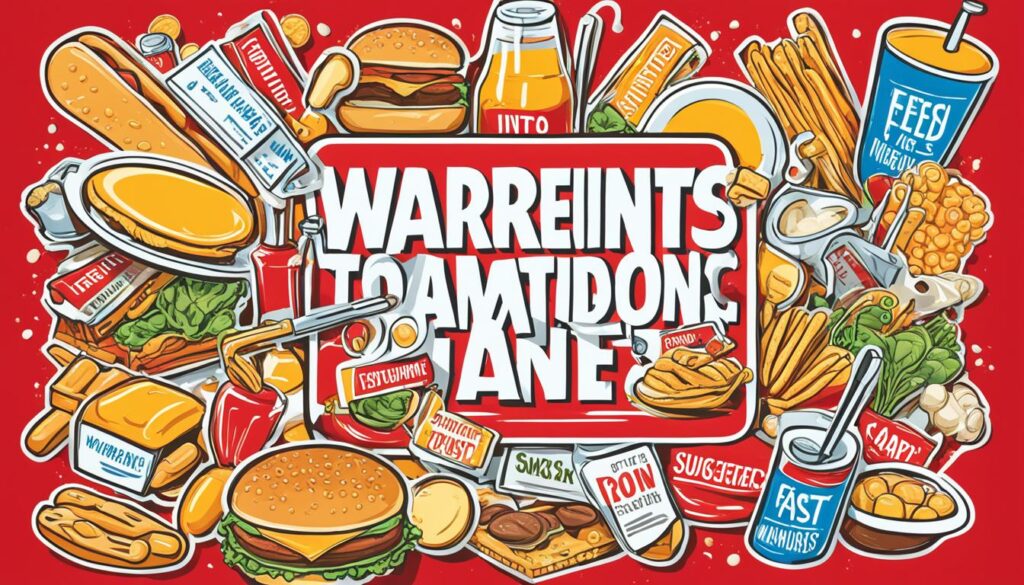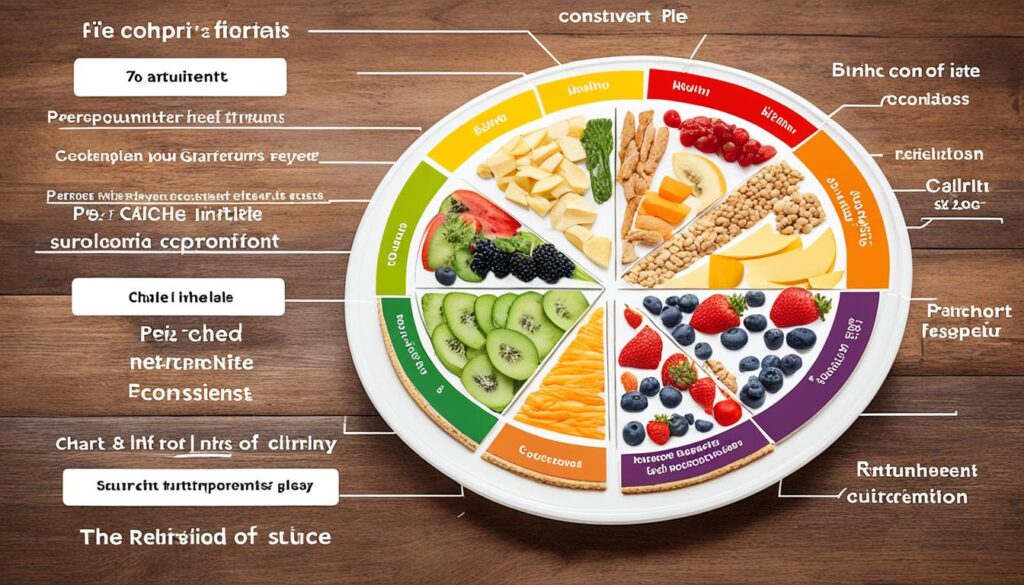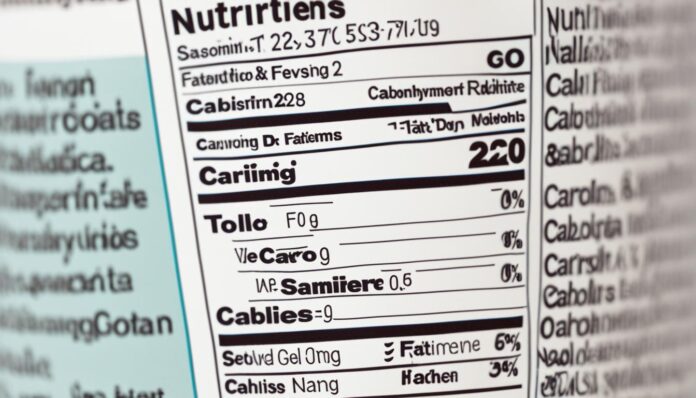The nutrition labels on packaged foods can seem daunting, but mastering their interpretation is a game-changer for making informed, healthy choices1. Manufacturers often use misleading health claims like “light,” “multigrain,” and “natural” on product labels to catch attention and convince consumers that the product is healthier than it may actually be1. In this comprehensive guide, we’ll dive into the key elements of nutrition labels and equip you with the knowledge to become a savvier, health-conscious consumer.
Key Takeaways
- Nutrition labels provide crucial information about the nutrient content and ingredients in packaged foods.
- Understanding serving size, calories, and nutrients to limit or increase can help you make more informed and healthier choices.
- Decoding front-of-package claims like “low-fat” and “organic” is essential to avoid being misled by marketing tactics.
- Comparing nutrition labels between similar products can assist you in selecting the healthier option.
- Paying attention to the order of ingredients and percent daily values (%DV) can reveal the true nutritional profile of a food.
Understanding Nutrition Labels
Nutrition labels are a valuable tool for making informed food choices that support your health. They provide a detailed breakdown of the nutritional content and ingredients in packaged foods and beverages2. Understanding the various sections of the nutrition label, such as serving size, calories, and key nutrients, is crucial for aligning your dietary intake with your personal health goals.
Overview of Nutrition Labels
Nutrition labels are required by the U.S. Food and Drug Administration (FDA) on most packaged foods and drinks sold in the United States3. These labels include important information such as the total number of servings, serving size, calories, and a breakdown of essential nutrients like fat, carbohydrates, protein, vitamins, and minerals3. The label also provides the percentage of Daily Value (%DV) for each nutrient, which helps consumers understand how the product fits into a balanced daily diet.
Importance of Reading Labels
Reading nutrition labels is essential for several reasons. First, it allows you to compare the nutritional content of different products and make informed purchasing decisions3. Additionally, understanding the serving size and number of servings in a package can help you monitor your calorie and nutrient intake4. By reviewing the % DV, you can identify foods that are high or low in specific nutrients, like saturated fat, sodium, and dietary fiber, and align your consumption with your dietary needs.
Nutrition labels also play a crucial role in managing health conditions, such as diabetes, heart disease, and food allergies3. By carefully reading the ingredient list and nutrient information, individuals can ensure they are avoiding ingredients that may be harmful or triggering for their specific dietary requirements.
“Nutrition labels are a powerful tool for empowering consumers to make informed, healthy choices. By understanding the information they provide, we can take control of our diets and support our overall well-being.”
In summary, nutrition labels offer a wealth of valuable information that can help you make healthier purchasing decisions, manage your nutrient intake, and maintain a balanced diet. Taking the time to read and comprehend these labels can be a game-changer for your health and well-being234.
Serving Information
Understanding serving sizes and calculating nutrient amounts are crucial when reading nutrition labels. The serving size, which is standardized to make it easier to compare similar foods, is key to interpreting the information provided on the label5. For example, the serving size for lasagna is 1 cup, or 227g5.
Understanding Serving Sizes
Serving sizes on nutrition labels represent the typical amount of food or drink that people consume, rather than an ideal portion5. This ensures the nutritional information reflects the reality of how the product is typically consumed. Some food packages even offer dual-column labels, indicating the nutritional facts for both a single serving and the entire package, helping consumers understand their total intake5.
Calculating Nutrient Amounts
The nutrient amounts shown on the label, including calories, refer to the specified serving size. To calculate the total nutrients you consume, you need to multiply the nutrient values by the number of servings you eat5. For instance, if you eat two servings of lasagna, you would need to double the nutrient amounts listed on the label to determine your total intake5.
Understanding serving sizes and calculating nutrient amounts is crucial for making informed decisions about your dietary intake. By paying close attention to this information on nutrition labels, you can better manage your overall health and wellness567.,,
“Serving sizes on food labels are required to represent the typical amount people consume rather than an ideal portion, ensuring accuracy in dietary information.”
Calories and Energy Balance
Understanding the calorie content of foods and beverages is crucial for maintaining a healthy energy balance. Calories provide an idea of how much energy you get from eating one serving of food8. The labels usually mention that calories are based on a diet of about 2000 total calories a day8. Grams are used to measure the amount of a nutrient or ingredient in each serving8. The FDA requires all packaged foods and beverages in the U.S. to have a Nutrition Facts Label, which includes information on serving size, calories, and the approximate daily value (%DV) for each nutrient based on a 2,000-calorie diet9.
To achieve and maintain a healthy body weight, it’s essential to balance the number of calories you consume with the number of calories your body uses. The calorie level can be categorized as low (40 calories per serving), moderate (100 calories per serving), or high (400 or more calories per serving)9. Consuming too many calories is linked to obesity, as eating more calories than burned results in weight gain9. Monitoring calorie intake based on food labels helps in balancing daily calorie needs to support health goals related to weight management10.
The %DV shows how much of each nutrient in one serving contributes to your daily nutrient needs8. %DV is based on a general daily intake of 2,000 calories, which can differ based on individual factors like age, sex, weight, and activity level8. Comparing nutrition labels when facing similar products assists in making choices that align with personal health goals10.
By understanding the calorie and nutrient information on food labels, you can make informed decisions that support your overall energy balance and health objectives8910.
Nutrients to Limit
When it comes to maintaining a healthy diet, it’s crucial to pay attention to the nutrients you may want to limit, such as saturated fat, trans fat, sodium, and added sugars. Consuming too much of these nutrients can increase your risk of developing heart disease, high blood pressure, and other health issues. By understanding how to read and interpret nutrition labels, you can make informed choices that support your overall well-being.
Saturated and Trans Fats
Saturated fats are found in many animal-based foods, such as meat, butter, and cheese, as well as some plant-based oils like coconut and palm oil. The 2020-2025 Dietary Guidelines for Americans recommend limiting saturated fat intake to less than 10% of your daily calorie intake11. For a person consuming around 2,000 calories per day, this would equal about 50 grams of saturated fat per day11. On the other hand, trans fats are often found in processed and fried foods, and they can have negative effects on your cholesterol levels. Foods containing less than 0.5g of trans fats per serving are allowed to label them as 0g11.
Healthy fats, such as monounsaturated and polyunsaturated fats, have various health benefits, like lowering bad cholesterol levels and improving blood sugar levels11. When selecting foods, aim to choose those with minimal or no trans fats and limit your intake of saturated fats.
Sodium and Added Sugars
Sodium is an essential nutrient, but consuming too much can contribute to high blood pressure and other health issues. The American Heart Association suggests women limit their daily sodium intake to 25g and men to around 37g11. Added sugars, on the other hand, can lead to weight gain and an increased risk of chronic diseases. The 2020-2025 Dietary Guidelines for Americans recommend limiting added sugars to less than 10% of daily calories11. For a person consuming around 2,000 calories per day, this would equal about 50 grams of sugar per day11. The American Heart Association further suggests women limit their daily sugar intake to 25g and men to around 37g11.
By focusing on the amounts of these nutrients on nutrition labels, you can make choices that help you stay within the recommended limits and support your overall health111213.

“It’s important to be mindful of the nutrients we’re consuming, as excess intake of certain nutrients like saturated fat, trans fat, sodium, and added sugars can increase the risk of chronic health conditions. Reading nutrition labels can help us make informed choices and maintain a balanced, healthy diet.”
Nutrients to Increase
While it’s important to limit certain nutrients like saturated and trans fats, sodium, and added sugars, the nutrition label can also guide you towards foods that are excellent sources of beneficial nutrients. Consuming adequate amounts of dietary fiber, vitamins, and minerals can help reduce the risk of various health issues and support your overall well-being12.
Dietary Fiber
Dietary fiber is a crucial nutrient that plays a vital role in digestive health, heart health, and weight management. The nutrition label can help you identify foods that are high in fiber, such as whole grains, fruits, vegetables, and legumes12. Aim to consume at least 25 to 30 grams of fiber per day for optimal health benefits14.
Vitamins and Minerals
The nutrition label provides information on the vitamin and mineral content of foods, allowing you to make choices that boost your intake of these essential nutrients. Look for foods that are high in vitamins A, B, C, D, and E, as well as minerals like calcium, iron, and potassium14. These nutrient-dense foods can help support immune function, bone health, and overall bodily processes12.
By focusing on increasing your consumption of dietary fiber, vitamins, and minerals, you can take an important step towards improving your overall nutrition and well-being. The information on the nutrition label can be a valuable tool in guiding you towards making informed and healthy food choices12.
“Nutrition labels can be a powerful resource for identifying nutrient-dense foods that provide the essential vitamins, minerals, and fiber your body needs to thrive.”
| Nutrient | High Amount | Low Amount |
|---|---|---|
| Fat | More than 17.5g per 100g | 3g or less per 100g |
| Saturated Fat | More than 5g per 100g | 1.5g or less per 100g |
| Sugars | More than 22.5g per 100g | 5g or less per 100g |
| Salt | More than 1.5g (0.6g sodium) per 100g | 0.3g (0.1g sodium) or less per 100g |
The nutrition label can also provide information on reference intakes to help you understand how a product fits into your daily recommended diet14. Additionally, color-coded nutritional information (red, amber, green) can indicate high, medium, or low amounts of specific nutrients, guiding you towards healthier choices121415.
Percent Daily Value (%DV)
The percent daily value (%DV) on nutrition labels is a valuable tool for understanding the nutritional content of the foods you consume. This percentage indicates how much a single serving of a food or beverage contributes to your recommended daily intake of a particular nutrient16. By learning to interpret the %DV, you can make more informed choices about the products you purchase and ensure your diet aligns with your personal health and wellness goals.
Understanding %DV
The %DV is based on a 2,000-calorie daily diet, which is a common reference point for many adults17. A %DV of 5% or less of a nutrient per serving is considered low, while 20% DV or more is considered high16. When it comes to nutrients like protein, trans fat, and total sugars, the %DV is not provided, so you’ll need to focus on the grams (g) listed instead16.
Using %DV for Comparison
Comparing the %DV of different products can help you make informed choices about the foods you consume. For example, a product with a 25% DV for saturated fat means that a single serving contains one-quarter of the recommended daily limit for this nutrient18. Conversely, a 200% DV for dietary fiber indicates that the serving provides double the recommended daily intake18. By focusing on the %DV, you can easily identify which items are high or low in key nutrients and make selections that support your overall health and wellness goals.

Understanding and utilizing the %DV on nutrition labels is a powerful tool for optimizing your diet and maintaining a healthy lifestyle. By considering this information alongside the other details on the label, you can make more informed decisions about the foods you choose, ensuring that your dietary choices align with your personal health objectives161718.
Reading Product Dates
Navigating the confusing array of product dates on food and beverage packages can be a challenge, but understanding their meaning is crucial for maintaining food safety19. Packaged goods often display multiple date labels, such as “sell by,” “use by,” and “best if used by,” each with its own significance20.
The “sell by” date indicates the last day a retailer should sell the product, allowing the consumer sufficient time to use it at home20. In contrast, the “use by” or “best if used by” date is the manufacturer’s recommendation for the last date the item should be consumed for optimal quality and flavor20.
It’s important to note that these dates do not necessarily indicate when a product is no longer safe to eat19. Many food items are still perfectly edible for some time after the “best by” date, provided they have been stored and handled properly19. Checking for signs of spoilage, such as off-smells or visible mold, is a more reliable indicator of food safety19.
By understanding the differences between these date labels, consumers can make more informed decisions about purchasing and using food products, ultimately reducing food waste and ensuring their safety1920.
In summary, the various date labels on food packaging provide useful information about a product’s quality and freshness, but they should not be the sole factor in determining whether a food is still safe to consume1920. By being mindful of storage conditions, visual cues, and the intended use of the product, consumers can make the most of the food they purchase and reduce the risk of foodborne illness192021.
Interpreting Ingredient Lists
The ingredient list on a nutrition label provides valuable insights into the specific components that make up a food product. By carefully reviewing this list, you can identify the presence of any ingredients you may want to limit or avoid, such as added sugars, artificial sweeteners, or unhealthy fats. Familiarizing yourself with common ingredient names and their potential health implications can empower you to make more informed purchasing decisions22.
Ingredients are listed in descending order by weight on food packages, with the most prevalent ingredients appearing first22. This means that the first few ingredients often make up the bulk of the product. Paying attention to the order of ingredients can help you quickly assess the overall composition of a food item.
Some key things to look for on the ingredient list include the presence of added sugars, which can have various names like “high fructose corn syrup,” “corn syrup,” or “dehydrated cane juice.”1123 Similarly, unhealthy fats like trans fats may be listed as “partially hydrogenated oils” or “hydrogenated oils.”23 Identifying these potentially concerning ingredients can guide you toward healthier food choices.
As a general rule, shorter ingredient lists are often preferred, as they typically indicate a less processed and more straightforward product22. Additionally, be mindful of any food allergens that may be present, such as milk, eggs, peanuts, tree nuts, fish, shellfish, soy, and wheat, which are required to be clearly labeled by law22.
| Recommended Nutrient Limits | Guideline |
|---|---|
| Added Sugars | Less than 10% of daily calories11 |
| Trans Fats | No more than 0.5g per serving11 |
| Sodium | No more than 1,500mg per day23 |
By becoming familiar with the information provided on ingredient lists, you can make more informed decisions about the foods you choose to consume. This understanding can help you select products that align with your dietary needs and preferences, ultimately supporting your overall health and well-being.
“Reading the ingredients list is crucial, as ingredients are listed in order of weight. Identify potentially harmful ingredients such as partially hydrogenated oils, high-fructose corn syrup, and artificial colorings to avoid highly processed foods.”11
Decoding Food Labels
When navigating the grocery aisles, you may come across various food labels and claims that can be confusing or misleading. Understanding the legal definitions and nutritional implications of terms like “light,” “low-fat,” “organic,” and “multigrain” can help you make more informed purchasing decisions that align with your dietary needs and preferences24.
Light and Low-Fat Claims
The term “light” on a food label can indicate that the product has been modified to contain less fat or calories than the original version. However, the specific requirements for using this claim vary by food category. For example, a “light” salad dressing must contain at least 50% less fat than the regular version, while a “light” snack food must have at least 33% fewer calories24. Similarly, “low-fat” means the product contains 3 grams or less of fat per 100 grams, and “high fat” means 17.5 grams or more per 100 grams24. It’s important to check the nutrition label to ensure that a “light” or “low-fat” claim aligns with your dietary needs.
Organic and Multigrain Labels
The term “organic” on a food label indicates that the product was grown or produced without the use of synthetic fertilizers, pesticides, or other prohibited substances. To be certified as organic, the product must meet strict standards set by the United States Department of Agriculture (USDA)25. In contrast, “multigrain” means the product contains more than one type of grain, but it does not necessarily imply that the grains are whole grains. Reviewing the ingredient list can help you determine the true composition of a “multigrain” product.
By understanding the legal definitions and nutritional implications of various food label claims, you can make more informed choices that support your health and wellness goals26. Carefully reading nutrition labels and ingredient lists can help you identify products that truly align with your dietary preferences, whether you’re seeking lower-calorie options, whole grain alternatives, or organic alternatives242526.
| Nutrient Claim | Definition |
|---|---|
| Low Fat | 3g or less per 100g |
| High Fat | 17.5g or more per 100g |
| Low Saturated Fat | 1.5g or less per 100g |
| High Saturated Fat | 5g or more per 100g |
| Low Sugar | 5g or less per 100g |
| High Sugar | 22.5g or more per 100g |
“Understanding food label terminology can empower consumers to make more informed choices that align with their health and wellness goals.”
Portion Control and Serving Sizes
Maintaining portion control and understanding serving sizes are crucial when interpreting nutrition labels. The serving size information provided on the label may not always align with the amount you typically consume in a single sitting27. Many people consume the entire package of food or beverage items without realizing the portion sizes indicated on the label, which can lead to overconsumption28. Larger portion sizes often lead to an excess of calories consumed, and28 many convenience foods and drinks are priced lower but packaged in larger sizes to promote more sales.
29 Recommended serving sizes can be established using measuring cups and spoons. For instance, 1 cup is equivalent to a baseball or an average-sized fist and is an appropriate portion size for raw or cooked vegetables, whole fruit, or 100% fruit juice29. ½ cup can be measured using a tennis ball or a small scooped handful, equal to 1-ounce equivalent for grains like pasta, rice, and oatmeal29. 3 ounce-equivalents, suitable for fish, chicken, beef, and other meats, can be measured with a deck of cards or the palm of the hand29. 1 tablespoon portion size, which is fitting for peanut butter or other nut spreads like almond butter, can be measured by the size of the thumb, and29 1 teaspoon portion size for oils or other fats is about the size of a postage stamp or the tip of the pointer finger to the first joint.
27 Understanding the difference between portion size (what you choose to eat) and serving size (amount on a product’s Nutrition Facts label) can help manage calorie intake more effectively28. There has been an increase in portion sizes of food prepared outside the home, exceeding federal guidance, and28 over the years, the availability of food per U.S. citizen has risen from 3400 calories to over 4000 calories, representing a 20% increase27. The serving size on food labels helps consumers understand the nutritional content they would be consuming by eating a portion of a particular food item, and27 the size of the portion you eat can impact your overall well-being, influencing factors like weight management, nutrition intake, and energy levels.
27 Portion distortion can occur when consumers misinterpret serving sizes on food labels, leading to unintentional overconsumption of calories, fats, carbs, and other nutrients27. Understanding how to read nutrition labels is crucial to making nutritious food choices, as serving sizes directly impact calorie intake and nutrient consumption27. Food labels typically provide serving sizes for various food items such as grains, fruits, vegetables, proteins, dairy products, fats, and condiments to help individuals make informed dietary choices.

27 Serving sizes on food labels are based on a 2,000-calorie diet, which may not be applicable to everyone and adjustments might be necessary based on individual requirements, such as age, sex, activity level, and dietary needs27. External factors, such as distractions and poor relationships with food, can influence how much individuals eat in one sitting.
| Recommended Serving Sizes | Approximate Visual Equivalents |
|---|---|
| 1 cup (raw or cooked vegetables, whole fruit, 100% fruit juice) | Baseball or average-sized fist |
| 1/2 cup (grains like pasta, rice, oatmeal) | Tennis ball or small scooped handful |
| 3 ounce-equivalents (fish, chicken, beef, other meats) | Deck of cards or palm of the hand |
| 1 tablespoon (peanut butter, other nut spreads) | Size of the thumb |
| 1 teaspoon (oils, other fats) | Postage stamp or tip of pointer finger to first joint |
“Paying attention to serving sizes and portion control is crucial when interpreting nutrition labels. Understanding how to translate the label’s nutrient and calorie information to the portion you actually eat can help you make more accurate assessments of your dietary intake and support your overall health and wellness goals.”
28 Recommended serving sizes include 1 slice of whole grain bread, 1/3 cup cooked rice, 1/2 cup cooked pasta, among others29. Many manufacturers have started to adapt the new Nutrition Facts label on their products29. The new Nutrition Facts label will appear on all food items by January 1, 202128.
How to Read Nutrition Labels: What You Need to Know
Deciphering nutrition labels can be a game-changer when it comes to making informed, healthy choices. By understanding the key components of these labels, you can empower yourself to select foods that align with your dietary needs and preferences2. The key to effectively using nutrition labels is to familiarize yourself with serving sizes, calorie content, nutrients to limit, and nutrients to increase, as well as the percent daily value (%DV).
Serving sizes are prominently displayed on nutrition labels to indicate what constitutes a single serving for a food item30. This information is crucial in understanding the overall nutritional content of a product and how it fits into your daily dietary intake2. For example, the sample label shows that one serving of lasagna contains 280 calories, but consuming the entire package would result in 1,120 calories2.
Calories and energy balance are essential considerations when reading nutrition labels2. Eating too many calories per day is linked to overweight and obesity2, while 2,000 calories a day is used as a general guide for nutrition advice2. Understanding the calorie content of a product can help you make better choices that support your overall health and fitness goals.
Nutrients to limit, such as saturated and trans fats, sodium, and added sugars, are also clearly displayed on nutrition labels22430. Americans generally consume too much of these nutrients, which can increase the risk of developing health conditions like cardiovascular disease and high blood pressure2. On the other hand, nutrients to increase, such as dietary fiber, vitamins, and minerals, are equally important to prioritize for a balanced and nutritious diet230.
The percent daily value (%DV) indicator on nutrition labels provides a helpful reference point for understanding the overall nutritional content of a product30. A %DV of 5% or less is considered low, while 20% or more is high, allowing you to compare and choose healthier options2.
By mastering the art of reading nutrition labels, you can make informed decisions that support your overall well-being2. Incorporating these label-reading skills into your shopping and cooking habits can empower you to create a healthier lifestyle and achieve your wellness goals2.
Resources for More Information
For additional information and resources on reading and understanding nutrition labels, visit reputable government and health organization websites. These sources offer detailed guides, interactive tools, and other helpful materials to further enhance your knowledge and skills in navigating nutrition labels and making informed dietary decisions.
The U.S. Food and Drug Administration (FDA) provides a comprehensive Nutrition Facts Label Guide that explains the various components of the nutrition label and how to use them effectively23. The U.S. Department of Agriculture (USDA) also offers a wealth of food and nutrition information, including educational resources on understanding and interpreting nutrition labels31.
The National Institutes of Health (NIH) is another valuable resource, with its Healthy Eating Guides that cover topics such as label reading, portion control, and making healthier food choices32. These guides provide practical tips and strategies to help you become a more informed and confident consumer when it comes to nutrition labels and making informed decisions about the foods you consume.
By utilizing these nutrition label resources, you can deepen your understanding of nutrition labels and how to use them effectively to support your overall health and wellbeing. Exploring these reliable sources can empower you to make more informed choices and take control of your dietary habits.
Remember, reading and understanding nutrition labels is an essential skill for maintaining a healthy lifestyle. By equipping yourself with the right knowledge and tools, you can navigate the food landscape with confidence and make choices that align with your personal health goals233132.
Conclusion
By learning how to effectively read and interpret nutrition labels, you can become a more informed and discerning consumer33. Understanding the serving size, calorie content, nutrients to limit and increase, and the percent daily value can empower you to make choices that align with your personal health goals and support your overall well-being3334., Applying these label-reading skills consistently can help you navigate the food landscape and make more mindful decisions about the products you purchase and consume.
The Nutrition Labeling and Education Act of 1990 mandated the creation of the Nutrition Facts label by the U.S. Food and Drug Administration to aid consumers in making informed food choices25. With the most recent update to the label released in 201625, you now have access to a wealth of information that can guide your purchases and support your health objectives. By understanding the regulations and guidelines that govern food labeling25, you can leverage this knowledge to make informed decisions that align with your dietary needs and preferences.
Ultimately, the key to applying nutrition label knowledge is consistency33. By making label-reading a habit, you can navigate the grocery aisles with confidence, identify products that meet your nutritional standards, and take an active role in maintaining a balanced, healthy diet. Remember, small steps can lead to significant improvements in your overall well-being, and the knowledge you gain from reading nutrition labels is a powerful tool to support your journey towards a healthier lifestyle.
FAQ
What information can I find on nutrition labels?
Nutrition labels provide valuable information about the nutritional content and ingredients in packaged foods and beverages, including serving size, calories, nutrients to limit (such as saturated and trans fats, sodium, and added sugars), and nutrients to increase (such as dietary fiber, vitamins, and minerals).
Why is it important to understand serving sizes on nutrition labels?
Serving sizes are standardized to make it easier to compare similar foods. It’s crucial to pay attention to the serving size, as all the nutrient amounts shown on the label, including calories, refer to the specified serving. Calculating the total nutrients you consume based on the number of servings you eat is key to understanding the overall nutritional profile of the product.
How can the calorie information on nutrition labels help me manage my intake?
The calorie content of a food or beverage is a measure of the energy it provides. The label’s calorie information can help you understand how a single serving of a product fits into your overall daily calorie needs, which vary based on factors like age, sex, height, weight, and physical activity level.
What nutrients should I try to limit based on the nutrition label?
The nutrition label highlights certain nutrients that you may want to limit in your diet, such as saturated and trans fats, sodium, and added sugars. Consuming too much of these nutrients can increase your risk of developing health conditions like heart disease and high blood pressure.
What beneficial nutrients can I look for on the nutrition label?
The nutrition label can also help you identify foods that are good sources of nutrients you may want to increase in your diet, such as dietary fiber, vitamins, and minerals. Consuming adequate amounts of these nutrients can help reduce the risk of various health issues and support overall well-being.
How can the percent daily value (%DV) on the nutrition label guide my dietary choices?
The percent daily value (%DV) on the nutrition label indicates the percentage of a recommended daily amount of a nutrient that a single serving of the food or beverage provides. Understanding how to interpret the %DV can help you determine if a product is high or low in a particular nutrient and make more informed comparisons between different food items.
What do the different product dates on labels mean?
Packaged foods and beverages often display various product dates, such as “sell by,” “use by,” and “best if used by.” These dates provide information about the expected quality and freshness of the item, but they do not necessarily indicate when a product is no longer safe to consume.
What should I look for when reviewing the ingredient list on a nutrition label?
By reviewing the ingredient list, you can identify the presence of any ingredients you may want to limit or avoid, such as added sugars, artificial sweeteners, or unhealthy fats. Familiarizing yourself with common ingredient names and their potential health implications can help you make more informed purchasing decisions.
How can I interpret the various claims and labels on food and beverage packaging?
Food and beverage packaging often includes various claims and labels, such as “light,” “low-fat,” “organic,” and “multigrain.” While these terms may seem to suggest healthier options, it’s important to understand their legal definitions and how they relate to the actual nutritional content of the product. Carefully reviewing the nutrition label and ingredient list can help you determine if a food or drink truly aligns with your dietary needs and preferences.
Source Links
- How to Read Food Labels Without Being Tricked
- How to Understand and Use the Nutrition Facts Label
- How To Read Food and Beverage Labels
- The Basics of the Nutrition Facts Label
- Serving Size on the Nutrition Facts Label
- Nutrition labels on food packaging: How to read them
- Nutrition: How to Read a Nutrition Facts Label – familydoctor.org
- How To Read Nutrition Food Labels – Fit Men Cook
- How to Read a Nutrition Facts Label | St. Joseph Health | St. Joseph Health
- Decoding Food Labels: How to Make Informed Choices at the Grocery Store
- What to Know About Reading Nutrition Labels – GoodRx
- Food labels
- How To Read Nutrition Labels the Right Way
- Reading nutrition labels can improve your overall health. Here’s why.
- How to Read a Food Label: Discover the Power of Nutrition Facts & Labels
- The Lows and Highs of Percent Daily Value on the Label
- How to Read a Food and Nutrition Label
- How to Read Nutrition Labels – Medical Associates of Northwest Arkansas
- How to read food labels: MedlinePlus Medical Encyclopedia
- Understanding Nutrition Facts on Food Labels
- Read the Label Youth Outreach Materials
- Easy Tips To Understand The Ingredient List On Food Labels
- Understanding Ingredients on Food Labels
- 10 tips for understanding food labels
- Understanding Food Labels
- How to Decode a Nutrition Label
- What Is a Serving Size?
- Portion Size Versus Serving Size
- Serving Size vs Portion Size: Is There a Difference?
- How to Get the Info You Need from Nutrition Labels | Banner
- Nutrition Facts Label and Your Health
- How to Read the Nutrition Facts Label on Packaged Foods
- Understanding Nutrition Labels
- Decoding Food Nutrition Labels for Time-Strapped Parents — Rite Aid Healthy Futures



